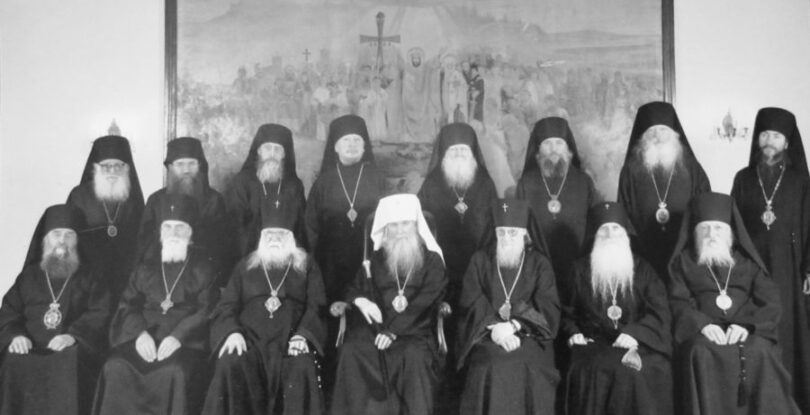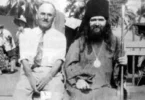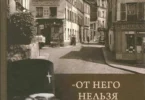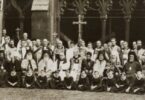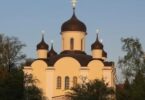Part III, Chapter 2
The Council of Bishops
In Orthodox ecclesiology, the importance of episcopal Councils in the life of the Church is stressed time and again. One thinks first of the Ecumenical Councils, which, in accordance with their title, represented the entire Orthodox Church. The decisions of the Ecumenical Councils are binding upon all of Orthodoxy. Alongside the Ecumenical Councils, there are also regional Councils, which are made up of several local Churches. In the individual local Orthodox Churches, the local Council forms the supreme ecclesiastical authority.
According to the decisions of the All-Russian Council of 1917/18, the lower clergy and laymen should also participate in church Councils. The decisions of the whole general assembly must, however, be endorsed by the bishops in order to be valid. The bishops meet afterward to agree upon the decisions of the general assembly. Thus, episcopal authority cannot thereby be overridden by a majority of the lower clergy and laity, since the bishops can refer decisions to the general assembly for renewed deliberations, or reject them altogether.
Both assemblies, the general Council and the Council of Bishops are referred to as the “Sobor” or Council. However, one must differentiate between the “Pan-Diaspora Council” and the “Council of Bishops.” Since the evacuation of the Supreme Ecclesiastical Administration in November of 1920, there have been, to date (updated to 1988), thirty-two Councils of Bishops. [1]The Synod archives in New York has an extensive collection of acts and documents from the councils since 1945: 1946, file 76/46; 1950, file 6/50; 1953, file 39/53; 1956, file 2/55; 1959, file 2/59; … Continue reading
The first Council of Bishops met during the Council of Karlovtsy in 1921. Thereafter, the bishops were supposed to meet yearly, which was the case in the 1930s. Since World War II, twenty-one Councils of Bishops have met at periodic intervals of approximately three years, though with greater frequency in the last few decades. [2] Nikon, „Arkhiereiskie Sobory” in Prav. Rus’ (1962) 21, pp. 3-6. The second Council of Bishops met in August of 1922. Twelve hierarchs took part in a person. This Council dissolved the Supreme Ecclesiastical Administration and transferred the temporary leadership of the Church Abroad to the “Provisional Synod of Bishops.” The assembly seems not to have considered itself representative of the whole Church Abroad since in the following year it summoned all the bishops to Karlovtsy, where the future leadership of the Church Abroad was to be rearranged.
The Council of 1923 created both the governing bodies which hitherto comprise the leadership of the Church Abroad: the Council of Bishops and the Synod of Bishops. The tasks and competence of both institutions were precisely defined and distinguished from one another.
The following, among other points, were set forth. [3] Tserk. Ved. (1922) 21, pp. 12-13, pp.3-4. The Council of Bishops forms the supreme authority for the entire Church Abroad and should meet annually. All bishops, or their appointed representatives, are to participate. Metropolitan Antony is to preside over the assembly. The Council of Bishops exercises jurisdiction over all matters of Faith and morality, the intensification of the spiritual life of the Church Abroad, and the question of education and missionary work. It acts in the name of the Russian Church Abroad as a whole and disseminates appeals and epistles for the entire Church Abroad. It appoints bishops, erects and abolishes dioceses, and selects episcopal candidates. It is enabled, as an ecclesiastical court, to make decisions over bishops if twelve participants of the assembly are present, which must include a minimum of seven bishops. [4] The fact that the bishops could be represented in voting by their clergy was restricted so that at an ecclesiastical trial of a bishop, at least seven bishops had to be present. At a Council of Bishops at least twelve bishops or their representatives must take part. The Council is also responsible for various financial matters. [5] Nikon, Zhizneopisanie, 7, pp. 35-36.
The supreme ecclesiastical authority of the Church Abroad was vested in the Council of Bishops. The decisions of the Council of 1923, at which twelve bishops took part in person and another sixteen by correspondence, remained in effect in the case of the Synod of Bishops for over ten years. In the “Provisional Statutes” [6] Cf. the “Document Appendix,” VII, 2. adopted in 1935, it states that the President of the Council of Bishops is also the President of the Synod of Bishops. All diocesan bishops are to take part in the sessions of the Council. Bishops who do not take part in person may send a proxy. Decisions at the Council require the vote of all participants and may be passed by the majority. A tie is decided by the vote of the President. Questions of a general ecclesiastical character, special matters of the Faith and morality, liturgics, the administration of the Church Abroad and discipline, as well as ecclesiastical jurisprudence fall to the Council of Bishops.
Furthermore, all matters of an international nature, such as the defense of the legal rights of the Russian Church Abroad before state and international organizations, as well as all questions in connection with schisms, are to be decided at a Council. In addition, the Council sends out all correspondence which concerns the Church Abroad as a whole, can erect and abolish episcopal sees, and change the boundaries of dioceses. All the bishops who endorsed the minutes acknowledged by these decisions the central significance of the Council of Bishops for their ecclesiastical provinces. After his return, Metropolitan Eulogius rejected the minutes after deliberations at a diocesan assembly. The rejection was certainly brought about because his authority and sphere of competence — despite the rights which he possessed as the administrator of a metropolitan province — would have been reduced. The Council of Bishops who held true to the Synod would have always had oversight over him and could have brought him before an ecclesiastical court for a violation of ecclesiastical order. The resolutions of the Council of Bishops of 1923 and the negotiations of 1935 defined the sphere of activity of both governing bodies of the Church Abroad. Essentially, this delineation of their areas of competence remains unchanged today.
The sessions of the Council of Bishops are conducted as follows: first, the President of the Council reports on important events in the life of the Church Abroad since the last Council meeting. To this are added reports by the diocesan bishops. Then matters which concern the Church Abroad as a whole are discussed: e.g., missionary work and religious instruction, the growth of church life, the condition and situation of the missions and monastic houses, church schools, printing presses, and charitable institutions. The bishops devote special attention to the sessions to questions of the religious upbringing of youth and parish life. In correspondence, they point to the necessity of observing the canons, maintaining the right Faith, and warning against modernist tendencies, sectarianism, and pseudo-religious groups. Almost every Council concerns itself in detail with the development and situation of the Russian Church in the homeland. In the past, after such discussions, the bishops often published appeals to the Free World, in which they drew attention to the suppression of religion in the Soviet Union and warned against state-sponsored atheism.
The Councils are opened and concluded with solemn divine services. Following the Synod’s move to the United States, all Councils of Bishops were held in North America, but recently (1993/4) in Western Europe as well. Today all bishops normally take part in the Council in person; but in case of illness or some extenuating circumstance, they can express their opinion and position as a corresponding member. In the 1920s and 1930s, twelve to fifteen bishops usually participated, primarily the bishops from Europe, while the majority of the bishops from the Far East and North America either sent proxies or statements in writing. Since World War II, more than twelve bishops have usually been present in person at the Councils; in 1959 as many as seventeen bishops participated. That was the Council at which the most bishops took part since 1921. [7] Prav. Rus´ (1959) 20, 11-12.
The following section gives a short synopsis of the individual Councils of Bishops, chronologically with their most important decisions. [8] Nikon, “Arkhiereiskii sobor” in Prav. Rus’ (1962) 21, pp. 3-6.
1921: This Council of Bishops met concurrently with the First Pan-Diaspora Council of the Church Abroad, in Sremsky-Karlovtsy. At the center of this Council are questions of the organization of the life of the Church Abroad. The Council advocated the restoration of the monarchy in Russia, while the question of dynasty resulted in differences of opinion. The minority faction(Archbishops Eulogius and Anastasius and Bishops Apollinarius, Benjamin, and Sergius) declined to endorse a particular dynasty on the grounds that such would be an exclusively political decision. In all, fifteen Russian (and two Serbian) bishops took part in the Council: Metropolitans Antony and Platon, Archbishops Eulogius, Anastasius, and Theophanes (Bystrov), and Bishops Apollinary, Benjamin, Damian, Gabriel, Germogen, Michael, Metrophanes, Seraphim, Sergius, and Theophanes (Gavrilov). [9] Cf. Deyaniya Karlovtsakh, here pp. 11-15.
1922: This Council resolved to dissolve the “Supreme Ecclesiastical Administration” and to set up a “Provisional Holy Synod of Bishops of the Russian Orthodox Church Abroad,” which was to be confirmed by an assembled Council of all the Bishops. Thirteen bishops participated. [10] Nikon, Zhizneopisanie, 7, pp. 19-22.
1923: At this Council a new structure of the Church Abroad was worked out. The supreme central governing body is the Council of Bishops, which is to meet once a year. Its executive body in between meetings of the Council is the Synod of Bishops, to which belong three permanent and five elected bishops with the right to vote. The Western European communities under the direction of Metropolitan Eulogius are granted autonomous status within the Church Abroad. At the Council twelve bishops took part in person and another sixteen by correspondence. [11] Ibid., 6, pp. 124-128; 7, pp. 33-40.
1924: This Council discussed the “Renovationists” as an illicit organization and warned the other local Orthodox Churches against recognizing these schismatics. The Council also dispatched a series of letters to ecclesiastical and governmental representatives to call attention to the difficult position of the Patriarchal Church. At this Council fourteen bishops took part in person, sixteen by correspondence. [12] Ibid., 6, pp. 122-124; 7, pp. 53-67.
1926: This Council resolved to recognize Metropolitan Peter of Krutitsy as the legitimate successor to the departed Patriarch Tikhon and, therefore, to commemorate him as the patriarchal locum tenens at all the divine services of the Church Abroad. Discussion of the central significance of the Synod as the “spiritual” or “canonical” authority of the Church Abroad brought several problems to remove “come” to ahead. The pretention to autonomy in Western Europe and North America remove “has” led to the schism of these regions from the Church Abroad. The bishops refused to adopt an autocephalous status for the Church Abroad. Eleven bishops take part in the Council. [13] Ibid., 7, pp. 107-123.
1928: At the center of discussion was the declaration of Metropolitan Sergius (Stragorodsky) and his demand for a declaration of total loyalty to the Soviet government. The Council confirms the break with the Patriarchal Church, but declares the Church Abroad to be an “inseparable part” of the whole Russian Church. The unity of the Russian Church continues to exist — the free part being formed by the Church Abroad, and the captive part by the Patriarchal Church. Metropolitans Eulogius and Platon, together with those bishops who remain subject to them, are suspended from serving. The formation of the Church Abroad’s own dioceses and communities in Western Europe and North America is confirmed. At the Council ten bishops participated in person, others in writing. [14] Ibid., pp. 185-213.
1931: At this Council, the proposal to convene an Eighth Ecumenical Council was rejected, because, given the lack of participation by the whole Russian Church (the Patriarchate and the Church Abroad), 90% of the Orthodox population would not be represented. The introduction of the New Calendar and the celebration of Pascha according to the Western Paschalion were categorically rejected. The situation of the Church in the Soviet Union and in emigration was discussed in detail. An appeal was addressed to the schismatic Metropolitans Eulogius and Platon and their bishops, pleading for the restoration of ecclesiastical unity. The proposal to appoint Metropolitan Antony as the locum tenens of the Patriarch and exarch of the Russian Church is rejected. Thirteen hierarchs participated in the Council in person, six hierarchs (from the Far East and North America) took part through correspondence. [15] Ibid., pp. 259-269.
1932: Above all else, internal ecclesiastical problems were discussed: Civil divorce was rejected as being incompatible with the canons; cremation of the dead was condemned as a godless custom, and freemasonry was condemned as an anti-Christian organization. [16] Ibid., pp. 284-310.
1933: This Council defined the competence of the Council of Bishops, the Synod of Bishops, and the President of the Synod. It also produced a detailed encyclical arguing against any collaboration with the atheist Soviet government and describing the formation and history of the Church Abroad from 1920. Metropolitan Sergius’ demands for loyalty to the Soviet government were again sharply condemned. The Council also expressed itself against the schism in the emigration. [17] Ibid., 6, pp. 269-298; 7, pp. 311-331.
1934: This Council appealed to Metropolitans Eulogius and Platon for reunification. The suspension from serving imposed upon Metropolitan Eulogius was vacated. At the Council, thirteen bishops participated, and six sent in their positions by correspondence. [18] Ibid., 7, pp. 349-368.
1935: This Council appointed Metropolitans Anthony and Anastasius to negotiate for the restoration of unity in the Russian Church emigration. It condemned the sophiological teachings of Archpriest Sergius Bulgakov. [19] Ibid., pp. 369-373.
1936: This Council approved negotiations for the restoration of unity with the American Metropolia and confirmed Metropolitan Anastasius as remove “the” successor to Metropolitan Antony. [20] Prav. Rus´ (1962) 21, p. 5.
1937: This Council resolved to convoke a Pan-Diaspora Council in 1938, with the participation of clergy and laity, on the occasion of the 950th anniversary of the Baptism of Russia. [21] Deyaniya vtorogo sobora, pp. 5-6.
1938: At the Pan-Diaspora Council, ecclesiastical and religious questions were the focal point of the discussions. The continued separation of Metropolitan Eulogius’s group was acknowledged with regret. Twenty-eight bishops of the Church Abroad participated in the Council, thirteen of them in person. The administrative reorganization, confirmed by the Council, remained in effect until the end of World War II. [22] Cf. the collected volumes Deyaniya vtorogo sobora.
1943: After the outbreak of the War, no further Councils took place. In 1943 eight hierarchs assembled at a Council of Bishops in Vienna, including two bishops of the Belorussian Autonomous Church. They condemned as uncanonical the election of Metropolitan Sergius as Patriarch of Moscow and issued an appeal calling for the liberation of Russia from Bolshevism. [23] Prav. Rus’ (1943) 11-12, pp.b 1-4.
1946: This first Council of Bishops after World War II was held in Munich in 1946. Fifteen bishops took part in person. Nine bishops from the Belorussian and Ukrainian Orthodox Autonomous Churches joined the Church Abroad at this Council. The assembly unanimously rejected an appeal from Patriarch Alexey I, whose election was condemned, to unite the Church Abroad with the Patriarchal Church. [24] Russ. Prav. Ts., 1, pp.134-137.
1950: For the first time in the history of the Church Abroad, a Council of Bishops met in North America. After the solemn consecration of the Holy Trinity Cathedral in Jordanville, the sessions took place at the New Kursk Hermitage, in Mahopac. The focus is on the reconstruction of parish life and the strengthening of church life. Metropolitan Anastasius and the bishops consecrate Holy Chrism. [25] Prav. Rus´ (1950) 22, pp. 1-3; 23-24, pp. 2-3, 8-9, 25-27; (1951) 1, pp. 4-8, 10-11; 2: pp. 8-10; 3, pp. 5-10; 4, pp. 10-12.
1953: The rebuilding of church life overseas and the provision of parishes with priests, as well as the education of priests, were discussed extensively. A commission was formed to prepare for the glorification of Saint John of Kronstadt. Sixteen bishops took part in person. [26] Prav. Rus’ (1953) 19, pp. 4-8; 20, pp. 3-6; 21, pp. 11-12; Tserk. Zhizn’ (1953) 9-12, pp. 161-168.
1956: The development of the Church Abroad and its relationship to the Patriarchal Church are discussed. With regard to cremation, the clergy must make clear that this is un-Christian. The importance of monasticism in the life of the Church Abroad was emphasized. [27] Prav. Rus’ (1956) 16, pp. 1-4; 18, pp. 1-3; 19, pp. 12-15; 20, pp. 2-4, 8-9; 21, pp. 3-5; Tserk. Zhizn´ (1956) 1-6, p. 57; 11-12, pp.141-153.
1959: For the first time, the Council met at the Synodal Cathedral on East 93rd Street in New York City. Of particular concern to the assembly was the supplying of the parishes with priests, because many of the clergies were elderly and there were not enough replacements amongst the rising generation to fill the ranks. The general recognition of the Patriarchal Church by the Free World was acknowledged with regret because the true situation of the Church and religion in the Soviet Union would no longer be truthfully represented. Seventeen bishops took part in the Council, including the exiled Romanian Bishop Theophilus. [28] Prav. Rus’ (1959) 20, pp. 11-12; 21, pp. 1-5, 13, 23: pp. 1-5; 24, pp. 10-11.
1962: The Patriarchal Church’s participation at the Orthodox Conference at Rhodes and its entry into the World Council of Churches moved the bishops to take a renewed stand on the situation of religion in the Soviet Union. [29] Ibid., (1962) 16, pp. 1-4; 20, pp. 10-11; 21, pp. 3-6; 23, pp. 8-9; Russ. Prav. Ts., 1, pp. 306-318.
1964: At this Council, Metropolitan Philaret was elected to succeed Metropolitan Anastasius. The glorification of Saint John of Kronstadt was the first canonization performed in the Russian Church in fifty years. This action by the Church Abroad was simultaneously a sign of its ecclesiastical independence and made good its promise as the free part of the Russian Church to act on behalf of the entire Russian Church. [30] Prav. Rus´ (1964) 11, pp. 4-9; 12, pp.1-2; Russ. Prav. Ts., 1, pp. 320-346.
1967: This Council reconfigured a number of dioceses and established four vicariates. Particular attention was devoted to the religious education of youth; broadening of the church school system was discussed. [31] Prav.Rus´ (1967) 12: pp. 5-11; Russ. Prav. Ts., 2, pp. 1442-1551.
1972: At the invitation of the head of the Canadian diocese, Archbishop Vitalis, the Council met in Montréal and discussed the 1971 election of Patriarch Pimen of Moscow. The election was repudiated as uncanonical, since it was not conducted in accordance with the decisions of the Pan-Russian Council of 1917-1918 concerning the election of a patriarch. The granting of autocephaly to the American Metropolia and of autonomy to the Japanese Orthodox Church was judged to be invalid because the Moscow Patriarchate was not the legitimate heir of Patriarch Tikhon’s Russian Church. The Church Abroad celebrated the fiftieth anniversary of its establishment. [32] Pamyatka, pp. 49-123.
1974: This Council met simultaneously with the Third Pan-Diaspora Council of the Church Abroad, to discuss the newly-manifested religious revival in the homeland and the decline of the Christian way of life in the West. Ecclesiastical developments in the Soviet Union and the consolidation and strengthening of the ecclesiastical life of the Church Abroad were discussed at length. [33] Prav. Rus´ (1974) 21, pp. 11-13; 22, pp. 13-14; “Die Russisch Orthodoxe Kirche im Ausland: Ihr III Gesamtkonzil” in G2W, 3/4 Q74.
1978: At this Council, Blessed Xenia, the Fool-for-Christ, was glorified as a saint. The situation of the Russian diaspora was discussed in particular detail. For the first time in the history of the Church Abroad, stress was placed on the multi-nationality of the Church Abroad remove “was stressed”, which now includes among its faithful not only Orthodox Russians, but also Orthodox Serbs, Romanians, Greeks, Chinese, Americans, Englishmen, Arabs, Germans, Frenchmen, Spaniards, and individuals of other nationalities. [34] Orthodox Life (1978) 6, pp. 19-22.
1981: At this Council, which met in New York City, fifteen bishops took part, and two bishops participated by correspondence due to illness (Archbishop Philotheus and Archbishop Nathaniel). The most significant decision was to glorify the New Martyrs and Confessors of Russia, the victims of Bolshevism martyred for the Orthodox Faith. Among the New Martyrs were Patriarch Tikhon, the Imperial Family and other members of the House of Romanov, numerous clergymen of all ranks, monks, nuns, and 30,000 of the faithful. Along with this, various administrative measures were taken, and Bishops Laurus, Nathaniel, and Paul were elevated to the rank of archbishop. The administration of the Diocese of Great Britain was entrusted to Bishop Constantine; the Diocese of Washington and Florida was formed as an independent diocese under the direction of Bishop Gregory of Manhattan.
[Trans.: This concludes the original text concerning the councils. The following accounts were added after the publication of the German edition.]Addendum to Part III, Chapter 2
1983: At this Council, fourteen bishops took part in person; four bishops were prevented from doing so due to ill health. The Council met at the Holy Transfiguration Skete in Canada, where for the first time the Wonder-working, Myrrh-streaming Iveron Icon of the Mother of God was also present. The focal point of the discussions was the situation of the Church and the faithful in the Soviet Union. Membership in the World Council of Churches was again rejected because the WCC attempts to create the impression that among its members there is no difference in faith. The Lima Liturgy was also sharply condemned. Ecumenism was declared a heresy, to be condemned by anathema at every Sunday of Orthodoxy service. Considering non-Russian speakers, it was decided that local languages may be introduced in parts of divine services.
1985: At this Council, again at the Transfiguration Skete, fifteen bishops took part in person. The focal point was the preparation for the celebration of the Millennium of the Baptism of Russia. The Council appealed to Russian youth in the Soviet Union to hold fast to the Orthodox Faith which has been handed down to them, in spite of atheist education and anti-religious propaganda. Moreover, the Council decided to review all available documents on the life and works of the Optina Elder Ambrose, with the possibility of his glorification envisioned.
1986: Fifteen bishops took part in this Council in person in New York City; two are unable to attend due to illness. At the Council, Archbishop Vitalis was elected to succeed Metropolitan Philaret as First Hierarch. Bishop Gregory retired as secretary of the Synod of Bishops after more than fifty years of dedicated service, on grounds of old age. His successor as secretary was Archbishop Laurus. Bishop Constantine retired due to ill health; Bishop Mark assumed the governance of the Diocese of Great Britain. Archbishop Anthony of Geneva was appointed a permanent member of the Synod.
1987: At this Council, administrative questions were the first order of business. Following the repose of Archbishop Nathaniel, the Diocese of Vienna and Austria was dissolved and its parishes were incorporated into the Western European Diocese. Bishop Alypius became the ruling bishop of the Diocese of Chicago and Detroit; Archbishop Seraphim of Chicago retired due to old age.
1988: At the Council, all thirteen bishops took part. The emphasis of the Council was on the Millennium celebrations in the diaspora and the homeland, the current Soviet conciliatory policies towards the Moscow Patriarchate, and administrative matters such as the need for a bishop in South America. Bishop Alypius was elevated to the rank of archbishop. A new bishop, Daniel, was consecrated for the newly-created vicariate of Erie, to care for the Old Ritualist faithful who returned to the Orthodox fold.
[Trans.: The above additions were by the translator.]References
| ↵1 | The Synod archives in New York has an extensive collection of acts and documents from the councils since 1945: 1946, file 76/46; 1950, file 6/50; 1953, file 39/53; 1956, file 2/55; 1959, file 2/59; 1962, file 5/61; 1964, file1/64; 1967, file 1/66; 1971, file 2/71; 1974, file 1/74; 1976, file 1/75; 1978, file 3/77. |
|---|---|
| ↵2 | Nikon, „Arkhiereiskie Sobory” in Prav. Rus’ (1962) 21, pp. 3-6. |
| ↵3 | Tserk. Ved. (1922) 21, pp. 12-13, pp.3-4. |
| ↵4 | The fact that the bishops could be represented in voting by their clergy was restricted so that at an ecclesiastical trial of a bishop, at least seven bishops had to be present. |
| ↵5 | Nikon, Zhizneopisanie, 7, pp. 35-36. |
| ↵6 | Cf. the “Document Appendix,” VII, 2. |
| ↵7 | Prav. Rus´ (1959) 20, 11-12. |
| ↵8 | Nikon, “Arkhiereiskii sobor” in Prav. Rus’ (1962) 21, pp. 3-6. |
| ↵9 | Cf. Deyaniya Karlovtsakh, here pp. 11-15. |
| ↵10 | Nikon, Zhizneopisanie, 7, pp. 19-22. |
| ↵11 | Ibid., 6, pp. 124-128; 7, pp. 33-40. |
| ↵12 | Ibid., 6, pp. 122-124; 7, pp. 53-67. |
| ↵13 | Ibid., 7, pp. 107-123. |
| ↵14 | Ibid., pp. 185-213. |
| ↵15 | Ibid., pp. 259-269. |
| ↵16 | Ibid., pp. 284-310. |
| ↵17 | Ibid., 6, pp. 269-298; 7, pp. 311-331. |
| ↵18 | Ibid., 7, pp. 349-368. |
| ↵19 | Ibid., pp. 369-373. |
| ↵20 | Prav. Rus´ (1962) 21, p. 5. |
| ↵21 | Deyaniya vtorogo sobora, pp. 5-6. |
| ↵22 | Cf. the collected volumes Deyaniya vtorogo sobora. |
| ↵23 | Prav. Rus’ (1943) 11-12, pp.b 1-4. |
| ↵24 | Russ. Prav. Ts., 1, pp.134-137. |
| ↵25 | Prav. Rus´ (1950) 22, pp. 1-3; 23-24, pp. 2-3, 8-9, 25-27; (1951) 1, pp. 4-8, 10-11; 2: pp. 8-10; 3, pp. 5-10; 4, pp. 10-12. |
| ↵26 | Prav. Rus’ (1953) 19, pp. 4-8; 20, pp. 3-6; 21, pp. 11-12; Tserk. Zhizn’ (1953) 9-12, pp. 161-168. |
| ↵27 | Prav. Rus’ (1956) 16, pp. 1-4; 18, pp. 1-3; 19, pp. 12-15; 20, pp. 2-4, 8-9; 21, pp. 3-5; Tserk. Zhizn´ (1956) 1-6, p. 57; 11-12, pp.141-153. |
| ↵28 | Prav. Rus’ (1959) 20, pp. 11-12; 21, pp. 1-5, 13, 23: pp. 1-5; 24, pp. 10-11. |
| ↵29 | Ibid., (1962) 16, pp. 1-4; 20, pp. 10-11; 21, pp. 3-6; 23, pp. 8-9; Russ. Prav. Ts., 1, pp. 306-318. |
| ↵30 | Prav. Rus´ (1964) 11, pp. 4-9; 12, pp.1-2; Russ. Prav. Ts., 1, pp. 320-346. |
| ↵31 | Prav.Rus´ (1967) 12: pp. 5-11; Russ. Prav. Ts., 2, pp. 1442-1551. |
| ↵32 | Pamyatka, pp. 49-123. |
| ↵33 | Prav. Rus´ (1974) 21, pp. 11-13; 22, pp. 13-14; “Die Russisch Orthodoxe Kirche im Ausland: Ihr III Gesamtkonzil” in G2W, 3/4 Q74. |
| ↵34 | Orthodox Life (1978) 6, pp. 19-22. |

